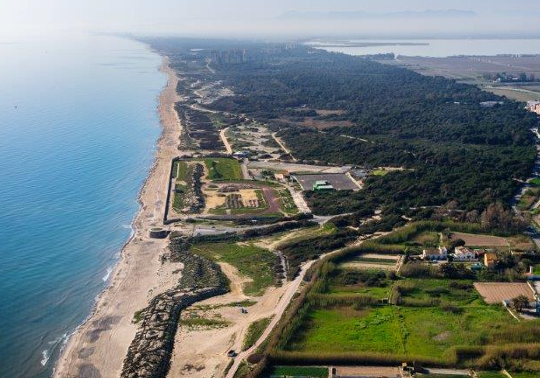The UV devotes an exhibition to the preservation of ‘El Saler’
- May 31st, 2017

The Universitat de València opens today at 20:00h at La Nau the exhibition ‘El Saler per al poble, ara! El poder de la ciudadanía en la transformación responsable del paisaje y del territorio’. This is a commemorative and rescindable event about the Devesa del Saler. This is organised by the Office of the Vice-Principal for Culture and Equality with the collaboration of the city council of Valencia, Caixa Popular, Professional Association of Architects of Valencia and the General Foundation of the Universitat de València.
The exhibition commemorates the success of the ‘El Saler per al poble’, one of the first citizen’s movements in Spain, which stopped in the 70s a development project that woul end up with la Devesa of El Saler, and defends the challenges of this natural park.
The exhibition is commissioned by the architects Carles Dolç, Tito Llopis, Felipe Martínez and Luis Alberto Perdigón, and also by the journalist Maria Josep Picó. It could be visited at the Sala Estudi General of La Nau until 15 October. The exhibition has been introduced this morning in a press conference with the attendance of Antonio Ariño, vice-principal for Culture and Equality of the Universitat de València; Sergi Campillo, the councillor responsible for Conservation of Natural Areas and Devesa-Albufera, the coordinators of the exhibition and Francesc Alós, the representative of Caixa Popular, the sponsor of this event.
“As it is reflected in the title of the exhibition, with this cultural activity we try to commemorate the first citizens’ movements in Spain, possibly the first ecological one that defended the natural heritage and is still being studied and analysed in some researches and doctoral thesis in European and American universities”, explains one of the coordinators, the architect Carles Dolç.
The Vice-Principal Antonio Ariño has emphasised the importance of this exhibition about “the urban and ecological fight, which is not new. In the 60s and 70s, the new social movements, headed by scientifics, architects and neighbours made visible those aspects such as the water and ducks of la Albufera”. In this sense, he has highlighted the relevance of the memory to valye the “historic conquests”.
The councillor Campillo has claimed that this exhibition is magnific because it recovers “one of the most important natural treasures of Valencia that commemorates this year the 30th anniversary as a natural park”. He has also expressed his gratitude for the work carried out by the Universitat de València. Likewise, Francesc Alós has revealed “the important role of La Nau in order to become closer to the society”. In particular, he has highlighted that thanks to the citizen’s movement, la Devesa is now what it is, but it could be something completely different.
According to Tito Llopis, the exhibition gathers a wide range of graphic and documentary material, which is characterised by its historic and unpublished nature. Photos of that period are combined with some aerial views of the area on the occasion of this expositive project. There are also audiovisual materials of the 70s together with recent ones that embody people from that successful citizens’ movement, and historic cartography documents appears together with urban planning material and some rescindable posters of that period.
The aim is to commemorate the “battle” of El Saler and the outstanding issues. In 1962, the Valencia City Council promoted a plan to urbanise it and turn it into another Mediterranean marine, intended to be a temporary accommodation of the “mass tourism” in which Manuel Fraga Iribarne, the then minister of Information and Tourism, proposed to colonise the most singular maritime areas. The Plan was approved on 1965 by the consistory chaired by the mayor Adolfo Rincón de Arellano, it began shortly after and at short notice we will see its damaging effects on the wood and on the El Saler beach.
Those final years of the sixties, some minority voices pointed out the initial critics to the urbanising process. They were biologists and environmentalists that checked the damages and the absence of previously established criteria with regard to the nature in the work in progress at the Saler. People such as professors Docavo, Mansanet and Gil Corell, as well as Félix Rodríguez de la Fuente with his TV programme “Vida Salvaje” in TVE in 1970, caused the first public controversy and casted doubts over the Valencian society about the benefits of the urbanisation of la Devesa.
El Saler for the people was the emblem of the citizen campaign that in the summer of 1974 raised emphatically that the urbanisation was a disaster and that la Devesa should be recovered. The citizen movement was supported by the neighbourhood associations born in the neighbourhoods and towns by the end of the Francois, and by the initiative of different professionals, sociologists (Josep Vicent Marqués), architects (Just Ramírez) lecturers (Trini Simó), journalist... The deputy director of Las Provincias, María Consuelo Reyna, published with criticism three articles about the project and, as a consequence, caused a long debate. 15,750 signatures were collected opposing to the urbanisation, an incredible number under the dictatorship.
The work of the citizen movement achieved the non-urbanisation. The buildings placed inside the woods of El Saler, the motorway that strangles it or the gold course are some of the memories or scars of an urbanisation that would have finished with La Devesa.
The first Valencian democratic corporation, chaired by Ricard Pérez Casado, paralysed definitely the implementation of the urbanising plan, started in 1980 the studies for the recovery of El Saler and approved the Special plan to protect La Devesa in 1982. After that, in 1986, the Valencian Government declared the Natural Park of La Albufera where La Devesa del Saler is included, started the regeneration of the dune systems (1990-2000) destroyed by the urbanisation and the planning of the tourism uses of the area.
Tge exhibition is divided in five sections: Precedents, in which it is possible to see some works that weren’t built such as the case of an airport or a university which finally was located in Cheste; analysis of the urban project carried out with the built “scars”; the citizens’ movement of 1974-1976. It occupies a preeminent place the exposure, informative and propositional organised in June 1974 at the Architect School with the title “El Saler: Dades per a una decisió col·lectiva’; a section addressed to the suspension of the plan and the rehabilitation works of Devesa ecosystems from the 80s; and finally the pending concessions: how to restore the beaches which have been modified by the growth of the Valencian Port, the recovery of the quality water of the lake like in the 60s, the anomaly of the motorway that drives us to the centre of the natural park, the golf course in opposition to the rich ecosystems of El Saler, the future of the existent buildings of La Devesa, the recovery of the link between the town and the harbour, etc.
This section, which has a visionary perspective, is accompanied by the book of the exhibition, which is not a catalogue. It is considered as a sum of items of different authors that updates a large part of the possible records -scientific, cultural and socials- in a singular and unique metropolitan landscape.
File in: Exposicions , Centre cultural La Nau , Vicerectorat de Cultura i Societat , Fundació General UV
















